Mitigation of Ice-Induced Vibration of Offshore Platform Based on Gated Recurrent Neural Network
Abstract
:1. Introduction
2. Numerical Model of Offshore Platform and Ice Load
2.1. Simplified Structural Model
2.2. Ice Load
3. Neural Network Model
3.1. Basis of LSTM and GRU
3.2. Forecast Network Model
3.3. Control Network Model
4. Network Model Analysis
4.1. Structural Analysis of Forecast Network
4.2. Analysis of Computing Structure of Control Network
5. Case Study
5.1. Prediction of Structural Ice-Induced Vibration Response
5.2. Control of The Ice-Induced Vibration
6. Conclusions
- (1)
- Based on the structural modal parameters, the structural parameters of the simplified model were identified. According to the verification results of its dynamic response, it is proved that the simplified model can well reflect the dynamic response characteristics of the original finite-element model.
- (2)
- A prediction model of ice-induced vibration response based on the GRU neural network is proposed, which can effectively predict the future structural response according to the current structural response of the platform, and is applied to the vibration control program to solve the problem of the control program time lag.
- (3)
- It is found that the LSTM and the GRU both can learn LQR optimal control algorithm well and have a good control effect for different working conditions, indicating that the LSTM has good robustness. The response control effect of the LSTM control strategy is slightly better than that of the GRU under the condition of sacrificing a certain calculation time.
Author Contributions
Funding
Institutional Review Board Statement
Informed Consent Statement
Data Availability Statement
Conflicts of Interest
References
- Sinha, N.K.; Timco, G.W.; Frederking, R. Recent Advances in Ice Mechanics in Canada. Appl. Mech. Rev. 1987, 40, 1214–1231. [Google Scholar] [CrossRef] [Green Version]
- Engelbrektson, A.; Janson, J.E. Field Observations of Ice Action on Concrete Structures in the Baltic Sea. Concr. Int. 1985, 7, 48–52. [Google Scholar]
- Zhang, D.; Yu, S.; Wang, Y.; Yue, Q. Sea Ice Management for Oil and Gas Platforms in the Bohai Sea. Pol. Marit. Res. 2017, 24, 195–204. [Google Scholar] [CrossRef]
- Szydłowski, M.; Kolerski, T. Numerical modeling of water and ice dynamics for analysis of flow around the Kiezmark Bridge piers. In Free Surface Flows and Transport Processes; Springer: Berlin/Heidelberg, Germany, 2018; pp. 465–476. [Google Scholar]
- Istrati, D.; Hasanpour, A.; Buckle, I. Numerical investigation of tsunami-borne debris damming loads on a coastal bridge. In Proceedings of the 17 World Conference on Earthquake Engineering, Sendai, Japan, 13–18 September 2020. [Google Scholar]
- Xiang, T.; Istrati, D. Assessment of Extreme Wave Impact on Coastal Decks with Different Geometries via the Arbitrary Lagrangian-Eulerian Method. J. Mar. Sci. Eng. 2021, 9, 1342. [Google Scholar] [CrossRef]
- Hasanpour, A.; Istrati, D.; Buckle, I. Coupled SPH–FEM Modeling of Tsunami-Borne Large Debris Flow and Impact on Coastal Structures. J. Mar. Sci. Eng. 2021, 9, 1068. [Google Scholar] [CrossRef]
- Abdussamie, N.; Thomas, G.; Amin, W.; Ojeda, R. Wave-in-deck forces on fixed horizontal decks of offshore platforms. In Proceedings of the International Conference on Offshore Mechanics and Arctic Engineering, San Francisco, CA, USA, 8–13 June 2014; American Society of Mechanical Engineers: New York, NY, USA, 2014; p. V1A. [Google Scholar]
- Gotoh, H.; Khayyer, A. Current achievements and future perspectives for projection-based particle methods with applications in ocean engineering. J. Ocean. Eng. Mar. Energy 2016, 2, 251–278. [Google Scholar] [CrossRef] [Green Version]
- Allsop, W.; Cuomo, G.; Tirindelli, M. New prediction method for wave-in-deck loads on exposed piers/jetties/bridges. In Proceedings of the Coastal Engineering 2006—30th International Conference, San Diego, CA, USA, 3–8 September 2006; Volume 5, pp. 4482–4493. [Google Scholar]
- Xiang, T.; Istrati, D.; Yim, S.C.; Buckle, I.G.; Lomonaco, P. Tsunami loads on a representative coastal bridge deck: Experimental study and validation of design equations. J. Waterw. Port. Coast. Ocean. Eng. 2020, 146, 4020022. [Google Scholar] [CrossRef]
- Istrati, D.; Buckle, I.; Lomonaco, P.; Yim, S. Deciphering the Tsunami Wave Impact and Associated Connection Forces in Open-Girder Coastal Bridges. J. Mar. Sci. Eng. 2018, 6, 148. [Google Scholar] [CrossRef] [Green Version]
- Istrati, D.; Buckle, I.G. Tsunami Loads on Straight and Skewed Bridges—Part 1: Experimental Investigation and Design Recommendations; Department of Transportation, Research Section: Salem, OR, USA, 2021. [Google Scholar]
- Istrati, D.; Buckle, I.G. Tsunami Loads on Straight and Skewed Bridges—Part 2: Numerical Investigation and Design Recommendations; Department of Transportation, Research Section: Salem, OR, USA, 2021. [Google Scholar]
- Zhang, D.; Xu, N.; Yue, Q.; Liu, D. Sea Ice Problems in Bohai Bay Oil and Gas Exploitation. J. Coast. Res. 2015, 73, 676–680. [Google Scholar] [CrossRef]
- Wang, S.; Yue, Q. Vibration Reduction of Bucket Foundation Platform with Fixed Ice-Breaking Cone in the Bohai Sea. J. Cold Reg. Eng. 2012, 26, 160–168. [Google Scholar] [CrossRef]
- Wang, S.; Yue, Q. Ice induced vibration and its isolation of an offshore platform with bucket foundations in marginal oilfields. In Proceedings of the 29th International Conference on Ocean, Offshore and Arctic Engineering, Shanghai, China, 6–11 June 2010; ASMEDC: Houston, TX, USA, 2010; Volume 4. [Google Scholar]
- Ji, S.; Wang, S. A Coupled Discrete–Finite Element Method for the Ice-Induced Vibrations of a Conical Jacket Platform with a GPU-Based Parallel Algorithm. Int. J. Comput. Methods 2019, 17, 1850147. [Google Scholar] [CrossRef]
- Wang, S.; Ji, S. DEM-FEM modelling interaction between level ice and conical jacket platform. In Proceedings of the 24th International Conference on Port and Ocean Engineering under Arctic Conditions, Busan, Korea, 11–16 June 2017. [Google Scholar]
- Wang, S.; Ji, S. Ice induced vibration of conical platform based on coupled DEM-FEM model with high efficiency algorithm. Haiyang Xuebao 2017, 39, 98–107. [Google Scholar]
- Zhang, D.; Wang, G.; Yue, Q. Evaluation of Ice-Induced Fatigue Life for a Vertical Offshore Structure in the Bohai Sea. Cold Reg. Sci. Technol. 2018, 154, 103–110. [Google Scholar] [CrossRef]
- Zhang, B.-L.; Han, Q.-L.; Zhang, X.-M. Recent Advances in Vibration Control of Offshore Platforms. Nonlinear Dyn. 2017, 89, 755–771. [Google Scholar] [CrossRef]
- Kandasamy, R.; Cui, F.; Townsend, N.; Foo, C.C.; Guo, J.; Shenoi, A.; Xiong, Y. A Review of Vibration Control Methods for Marine Offshore Structures. Ocean. Eng. 2016, 127, 279–297. [Google Scholar] [CrossRef]
- Li, D.; Zhang, D.; Yue, Q. Phase analysis on the mechanism of TMD and mitigation of ice-induced vibrations for jacket platforms with TMD. In Proceedings of the 29th International Conference on Ocean, Offshore and Arctic Engineering, Shanghai, China, 6–11 June 2010; Volume 49125, pp. 837–845. [Google Scholar]
- Wu, B.; Shi, P.; Wang, Q.; Guan, X.; Ou, J. Performance of an Offshore Platform with MR Dampers Subjected to Ice and Earthquake. Struct. Control. Health Monit. 2010, 18, 682–697. [Google Scholar] [CrossRef]
- Ghadimi, B.; Taghikhany, T. Dynamic Response Assessment of an Offshore Jacket Platform with Semi-Active Fuzzy-Based Controller: A Case Study. Ocean. Eng. 2021, 238, 109747. [Google Scholar] [CrossRef]
- Ma, H.; Zhang, Y.; Tang, G.-Y.; Zhang, B.-L. BP Neural network vibration control with time delay for offshore platforms under wave forces. In Proceedings of the 2017 36th Chinese Control Conference (CCC), Dalian, China, 26–28 July 2017. [Google Scholar]
- Cui, H.; Hong, M. Adaptive inverse control of offshore jacket platform based on grey prediction. In Proceedings of the 2011 Second International Conference on Digital Manufacturing; Automation, Zhangjiajie, China, 5–7 August 2011. [Google Scholar]
- Chen, P.-C.; Chien, K.-Y. Machine-Learning Based Optimal Seismic Control of Structure with Active Mass Damper. Appl. Sci. 2020, 10, 5342. [Google Scholar] [CrossRef]
- Wang, Q.; Wang, J.; Huang, X.; Zhang, L. Semiactive Nonsmooth Control for Building Structure with Deep Learning. Complexity 2017, 2017, 1–8. [Google Scholar] [CrossRef] [Green Version]
- Gao, J.; Zhang, C. Structural Seismic Response Prediction Based on Long Short-Term Memory Network. Earthq. Resist. Eng. Retrofit. 2020, 42, 130–134. [Google Scholar] [CrossRef]
- Tu, J.; Gao, J.; Li, Z.; Zhang, J. Research on Structural Intelligent Control Algorithms Based on Long Short-Term Memory Networks. J. Huazhong Univ. Sci. Tech. (Nat. Sci. Ed.) 2019, 47, 110–115. [Google Scholar] [CrossRef]
- China Nation Offshore Oil Corporation. Provisions for Sea Ice Conditions and Applications in the China Sea; China Nation Offshore Oil Corporation: Tianjin, China, 2002. [Google Scholar]
- China Classification Society. Guide for Analysis of Ice-induced Vibration and Ice-induced Fatigue of Stationary Marine Steel Structures; China Classification Society: Beijing, China, 2018. [Google Scholar]
- Wang, S.; Li, H.; Ji, C.; Jiao, G. Energy Analysis for TMD-Structure Systems Subjected to Impact Loading. Chain. Ocean. Eng. 2002, 16, 301–310. [Google Scholar]
- Kärnä, T.; Qu, Y.; Ku Hnlein, W.L. A New spectral method for modeling dynamic ice actions. In Proceedings of the 23rd International Conference on Offshore Mechanics and Arctic Engineering, Vancouver, BC, Canada, 20–25 June 2004; pp. 953–960. [Google Scholar]
- Shinozuka, M.; Jan, C.-M. Digital Simulation of Random Processes and Its Applications. J. Sound Vib. 1972, 25, 111–128. [Google Scholar] [CrossRef]
- Anagnostopoulos, S.A. Dynamic response of offshore platforms to extreme waves including fluid-structure interaction. Eng. Struct. 1982, 4, 179–185. [Google Scholar] [CrossRef]
- Istrati, D.; Buckle, I.G. Effect of fluid-structure interaction on connection forces in bridges due to tsunami loads. In Proceedings of the 30th US-Japan Bridge Engineering Workshop, Washington, DC, USA, 21–23 October 2014; pp. 21–23. [Google Scholar]
- Choi, S.; Lee, K.; Gudmestad, O.T. The effect of dynamic amplification due to a structure’s vibration on breaking wave impact. Ocean. Eng. 2015, 96, 8–20. [Google Scholar] [CrossRef]
- Istrati, D.; Buckle, I.; Lomonaco, P.; Yim, S.; Itani, A. Large-scale experiments of tsunami impact forces on bridges: The role of fluid-structure interaction and air-venting. In Proceedings of the 26th International Ocean and Polar Engineering Conference, Rhodes, Greece, 26 June 2016. [Google Scholar]
- Sharafati, A.; Tafarojnoruz, A.; Motta, D.; Yaseen, Z.M. Application of nature-inspired optimization algorithms to ANFIS model to predict wave-induced scour depth around pipelines. J. Hydroinform. 2020, 22, 1425–1451. [Google Scholar] [CrossRef]
- Sharafati, A.; Tafarojnoruz, A.; Shourian, M.; Yaseen, Z.M. Simulation of the depth scouring downstream sluice gate: The validation of newly developed data-intelligent models. J. Hydro-Environ. Res. 2020, 29, 20–30. [Google Scholar] [CrossRef]
- Sharafati, A.; Tafarojnoruz, A.; Yaseen, Z.M. New stochastic modeling strategy on the prediction enhancement of pier scour depth in cohesive bed materials. J. Hydroinform. 2020, 22, 457–472. [Google Scholar] [CrossRef]
- Hochreiter, S.; Schmidhuber, J. Long Short-Term Memory. Neural Comput. 1997, 9, 1735–1780. [Google Scholar] [CrossRef]
- Cho, K.; van Merrienboer, B.; Bahdanau, D.; Bengio, Y. On the Properties of Neural Machine Translation: Encoder—Decoder Approaches. Available online: https://arxiv.org/abs/1409.1259 (accessed on 1 June 2021).
- Cho, K.; van Merrienboer, B.; Gulcehre, C.; Bahdanau, D.; Bougares, F.; Schwenk, H.; Bengio, Y. Learning Phrase Representations Using RNN Encoder—Decoder for Statistical Machine Translation. Available online: https://arxiv.org/abs/1406.1078 (accessed on 1 June 2021).
- Chung, J.; Gulcehre, C.; Cho, K.; Bengio, Y. Empirical Evaluation of Gated Recurrent Neural Networks on Sequence Modeling. Available online: https://arxiv.org/abs//1412.3555 (accessed on 1 June 2021).
- Srivastava, N.; Hinton, G.; Krizhevsky, A.; Sutskever, I.; Salakhutdinov, R. Dropout: A Simple Way to Prevent Neural Networks from Overfitting. J. Mach. Learn. Res. 2014, 15, 1929–1958. [Google Scholar]
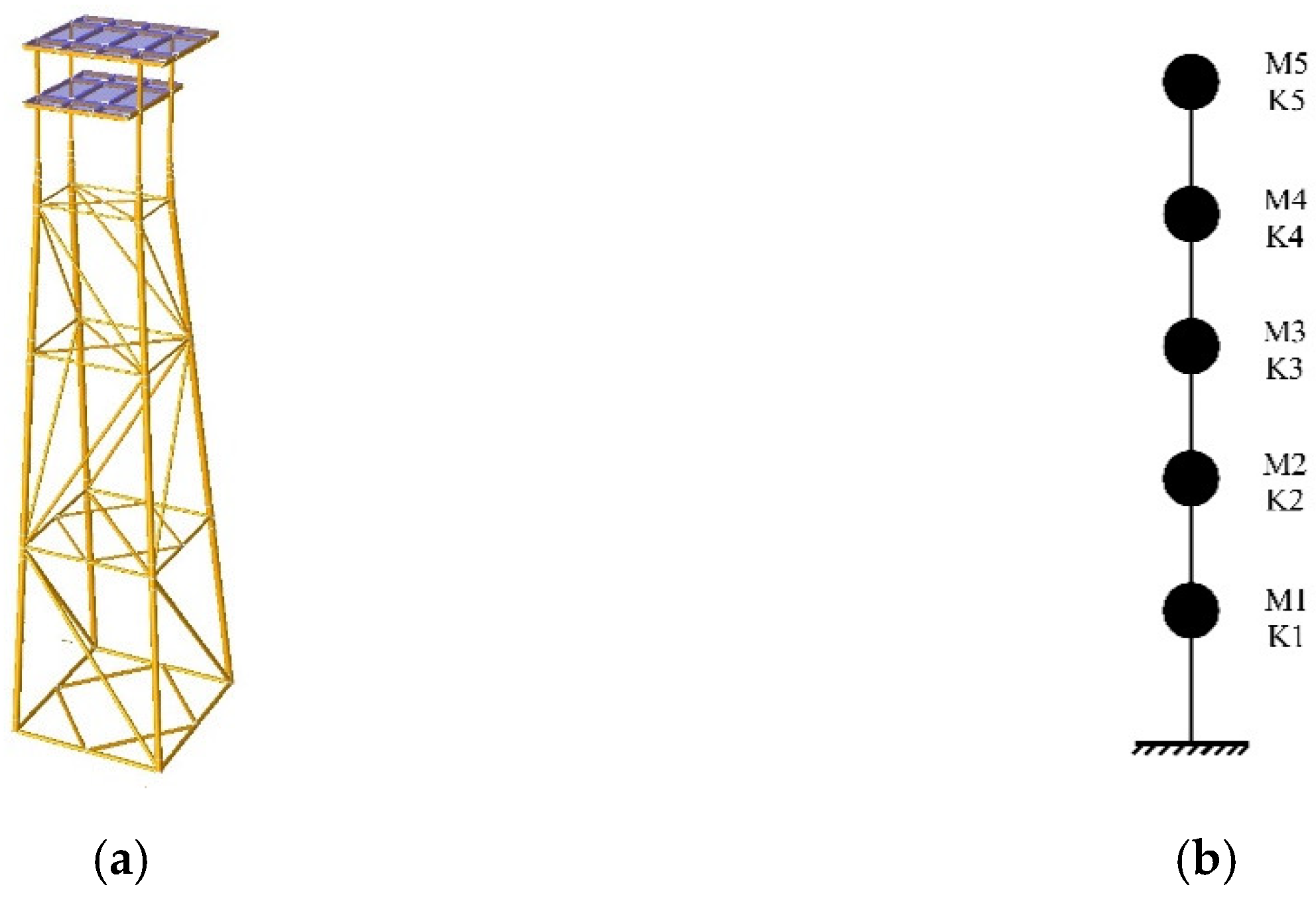
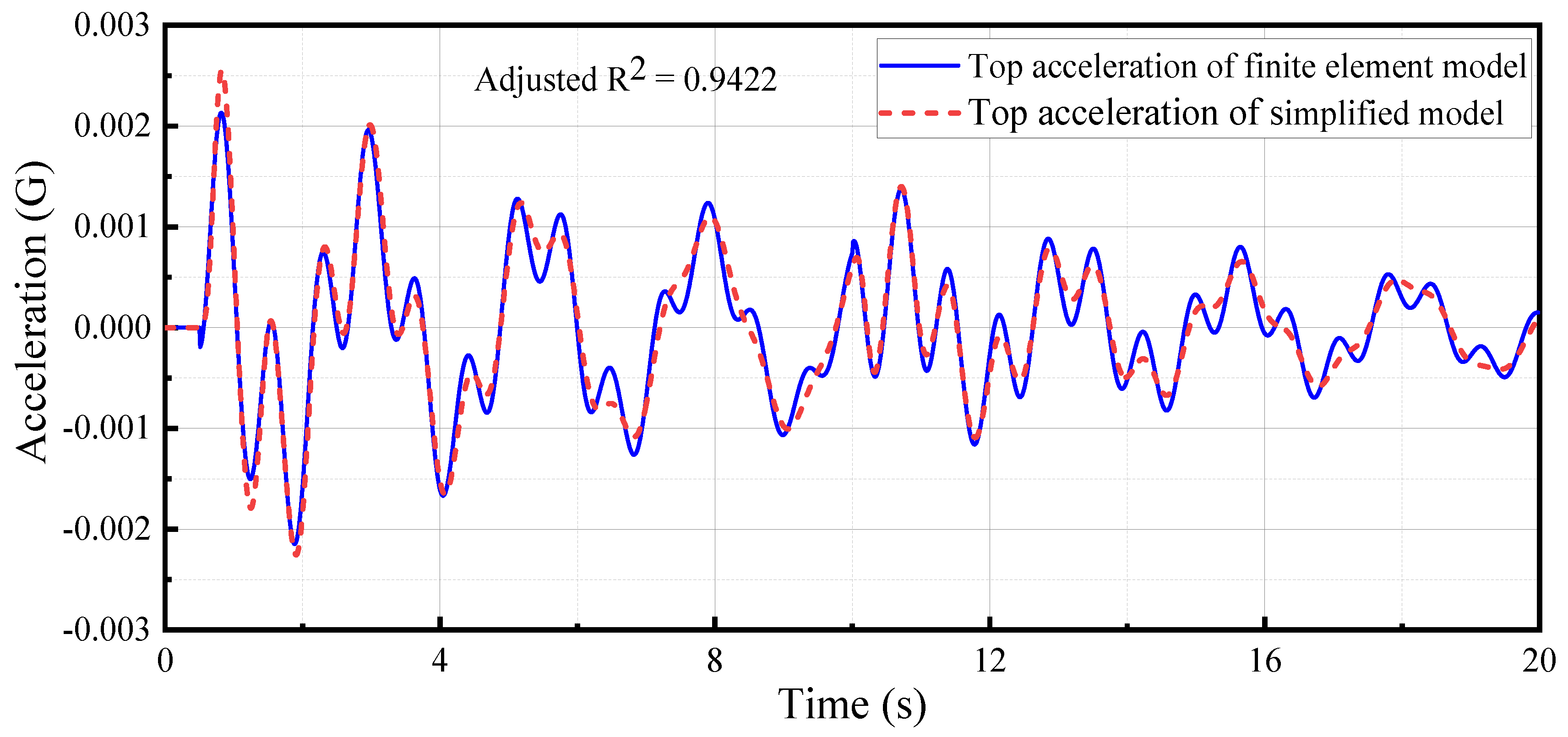
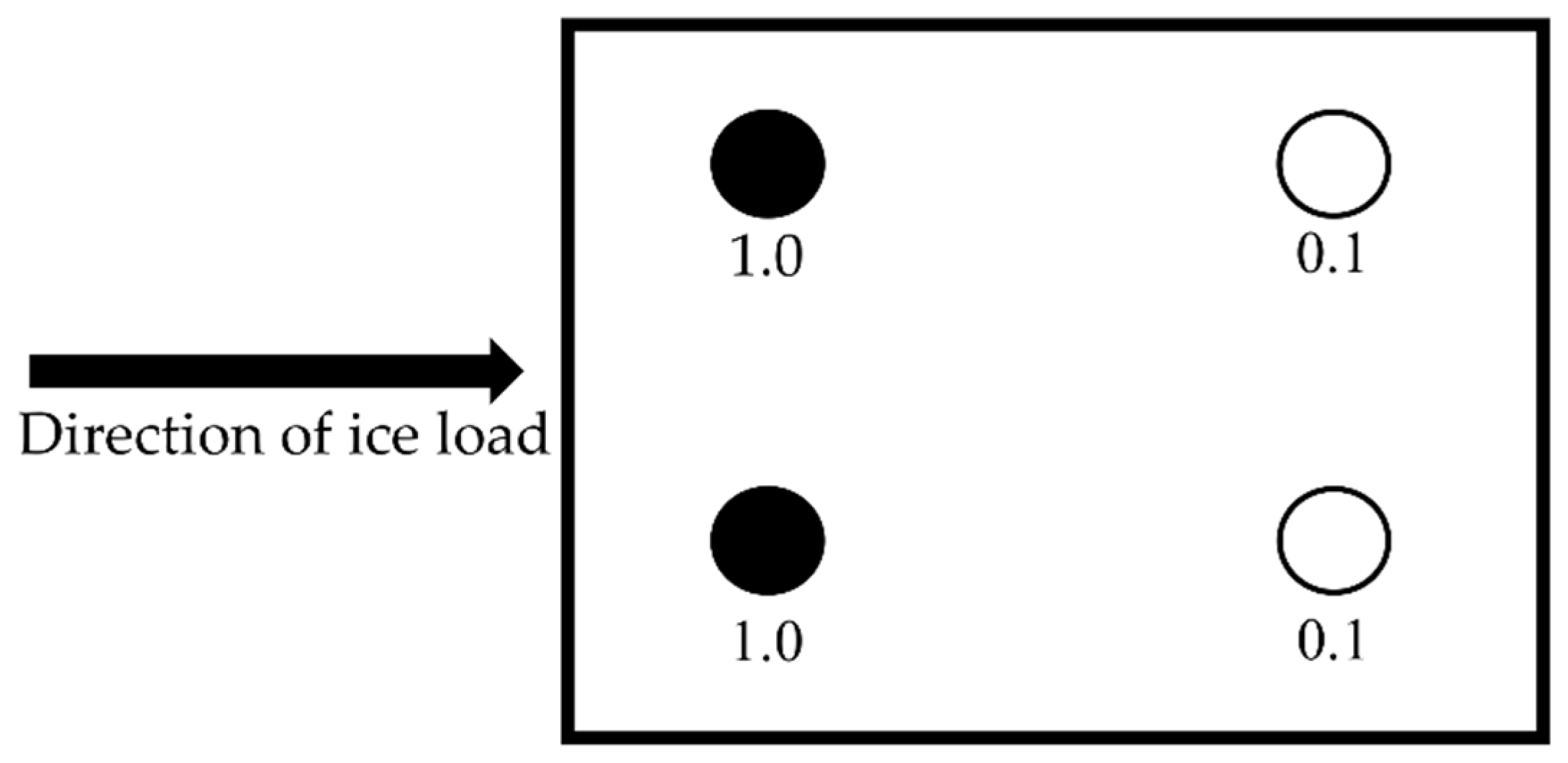

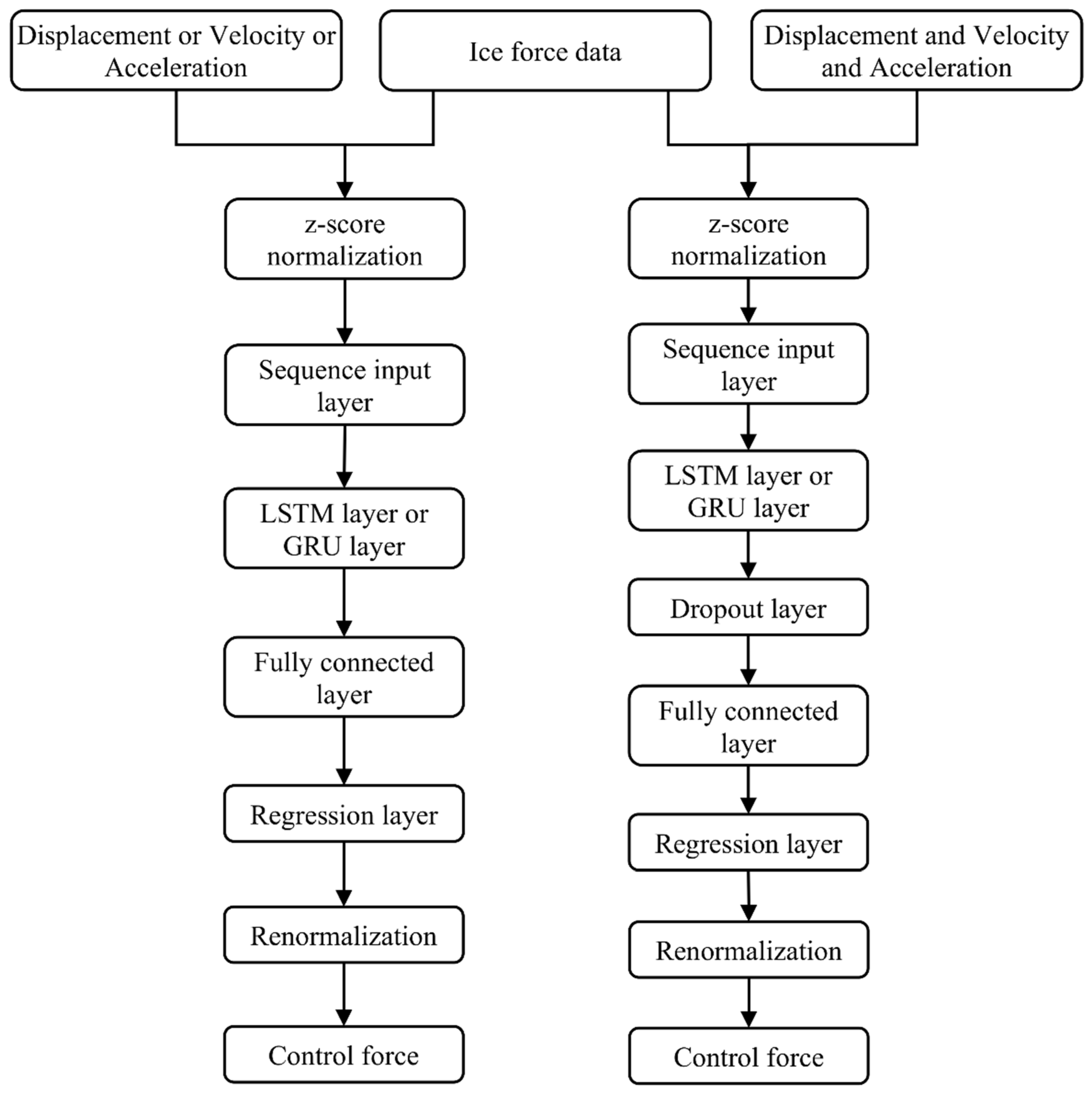
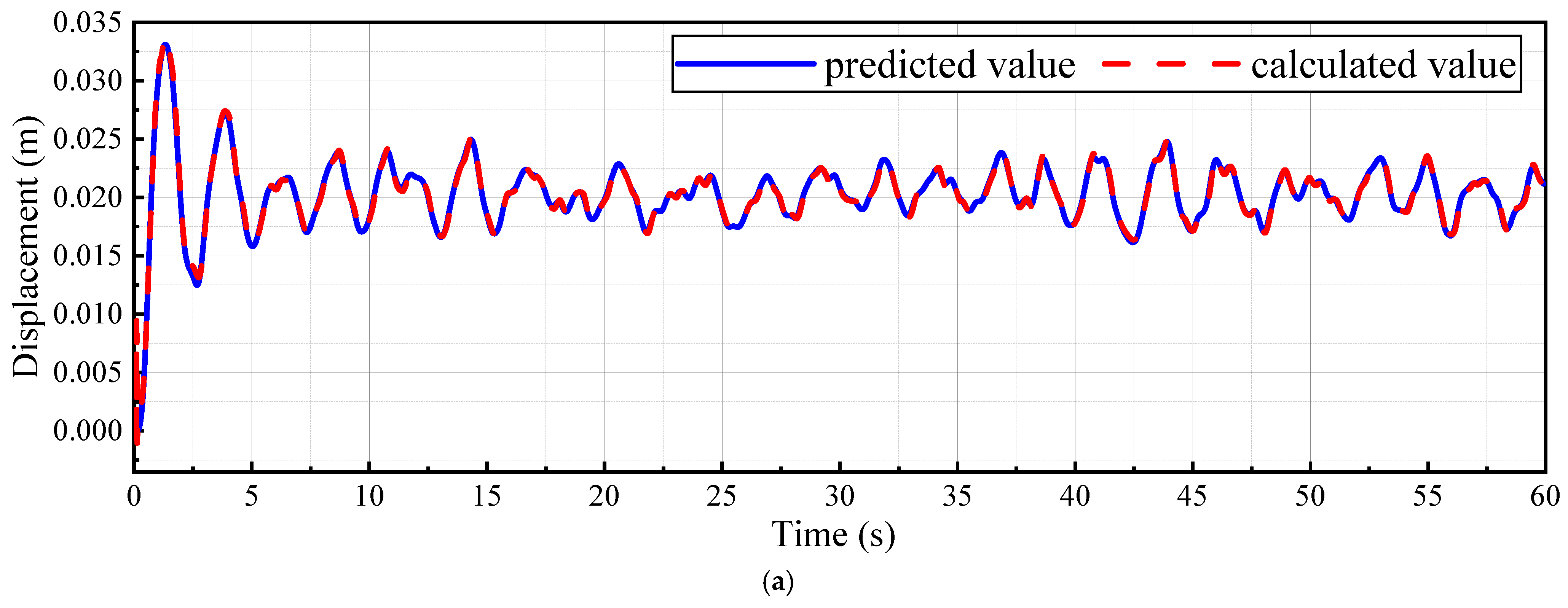
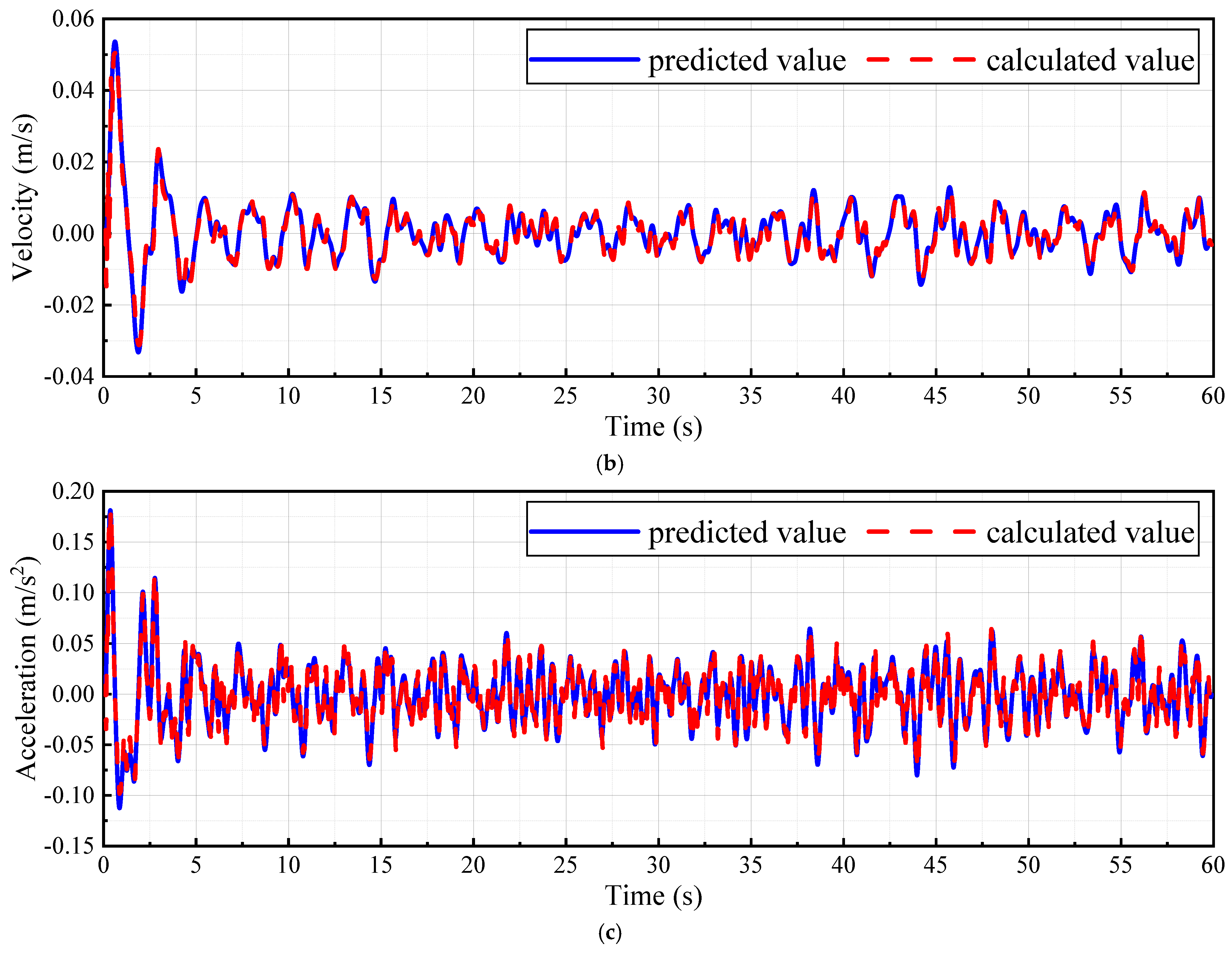

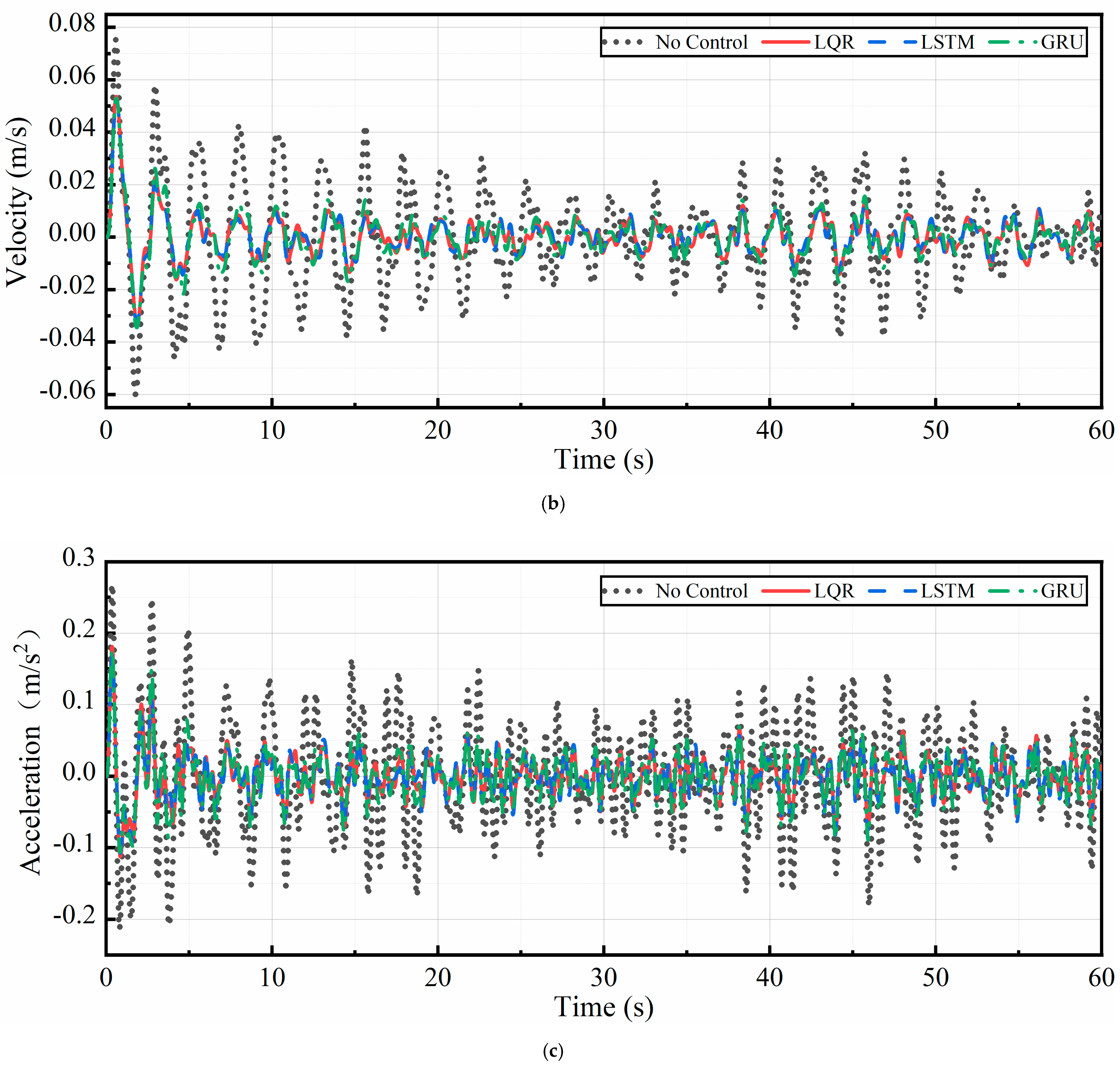
| Name of Parameter | Value |
|---|---|
| E (kN/cm2) | 20,000 |
| G (kN/cm2) | 7722 |
| Fy (kN/cm2) | 34.5 |
| Density (T/m3) | 7.849 |
| Height (m) | Equivalent Stiffness (kg/m) | Equivalent Mass (kg) |
|---|---|---|
| −50 | 1.433 × 108 | 614,190 |
| −21 | 7.138 × 108 | 421,309 |
| 0 | 4.432 × 108 | 132,653 |
| 15.3 | 5.567 × 108 | 131,660 |
| 23 | 1.285 × 108 | 426,815 |
| Network Type | Ice Conditions | Adjusted R2 | ||
|---|---|---|---|---|
| Displacement | Velocity | Acceleration | ||
| GRU Network | V = 0.8 m/s, H = 0.4 m, σ = 2.2 MPa | 0.9929 | 0.9685 | 0.9322 |
| V = 1.0 m/s, H = 0.5 m, σ = 2.0 MPa | 0.9925 | 0.9725 | 0.9286 | |
| V = 1.0 m/s, H = 0.46 m, σ = 1.6 MPa | 0.9833 | 0.9698 | 0.9322 | |
| LSTM Network | V = 0.8 m/s, H = 0.4 m, σ = 2.2 MPa | 0.9814 | 0.9652 | 0.9036 |
| V = 1.0 m/s, H = 0.5 m, σ = 2.0 MPa | 0.9888 | 0.9710 | 0.8995 | |
| V = 1.0 m/s, H = 0.46 m, σ = 1.6 MPa | 0.9283 | 0.9679 | 0.9056 | |
| GRU | LSTM | |||||||
|---|---|---|---|---|---|---|---|---|
| Input 1 | Input 2 | Input 3 | Input 4 | Input 1 | Input 2 | Input 3 | Input 4 | |
| MAX | 0.868 | 0.891 | 0.857 | 0.986 | 0.969 | 0.897 | 0.911 | 0.983 |
| MIN | 0.397 | 0.501 | −0.721 | 0.942 | 0.784 | 0.588 | 0.508 | 0.928 |
| AVG | 0.778 | 0.772 | 0.443 | 0.972 | 0.935 | 0.829 | 0.815 | 0.964 |
| S.D. | 0.080 | 0.071 | 0.237 | 0.009 | 0.026 | 0.042 | 0.067 | 0.010 |
| Control Strategy | Displacement (cm) | Velocity (cm/s) | Acceleration (cm/s2) | |||
|---|---|---|---|---|---|---|
| Peak | Drop | Peak | Drop | Peak | Drop | |
| Without control | 4.20 | - | 7.53 | - | 26.81 | - |
| LQR | 3.30 | 21.24% | 5.36 | 28.79% | 18.13 | 32.40% |
| GRU | 3.44 | 18.21% | 5.30 | 29.66% | 17.71 | 33.96% |
| LSTM | 3.34 | 20.42% | 5.23 | 30.58% | 17.02 | 36.54% |
Publisher’s Note: MDPI stays neutral with regard to jurisdictional claims in published maps and institutional affiliations. |
© 2022 by the authors. Licensee MDPI, Basel, Switzerland. This article is an open access article distributed under the terms and conditions of the Creative Commons Attribution (CC BY) license (https://creativecommons.org/licenses/by/4.0/).
Share and Cite
Zhang, P.; Wu, Z.; Cui, C.; Yao, R. Mitigation of Ice-Induced Vibration of Offshore Platform Based on Gated Recurrent Neural Network. J. Mar. Sci. Eng. 2022, 10, 967. https://doi.org/10.3390/jmse10070967
Zhang P, Wu Z, Cui C, Yao R. Mitigation of Ice-Induced Vibration of Offshore Platform Based on Gated Recurrent Neural Network. Journal of Marine Science and Engineering. 2022; 10(7):967. https://doi.org/10.3390/jmse10070967
Chicago/Turabian StyleZhang, Peng, Zhihao Wu, Chunyi Cui, and Ruqing Yao. 2022. "Mitigation of Ice-Induced Vibration of Offshore Platform Based on Gated Recurrent Neural Network" Journal of Marine Science and Engineering 10, no. 7: 967. https://doi.org/10.3390/jmse10070967
APA StyleZhang, P., Wu, Z., Cui, C., & Yao, R. (2022). Mitigation of Ice-Induced Vibration of Offshore Platform Based on Gated Recurrent Neural Network. Journal of Marine Science and Engineering, 10(7), 967. https://doi.org/10.3390/jmse10070967







